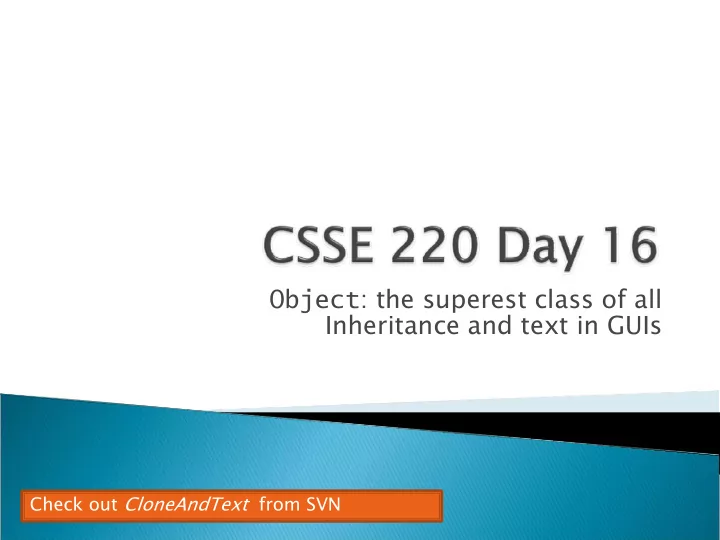

Object : the superest class of all Inheritance and text in GUIs Check out CloneAndText from SVN
• Interfaces • Inheritance • extends vs implements • abstract classes and methods • polymorphism • Hardy's taxi •anything else
The superest class in Java
� Every Every class in Java inherits from Object ◦ Directly and explicitly explicitly: � public class String extends Object {…} ◦ Directly and implicitly implicitly: � class BankAccount {…} ◦ Indirectly Indirectly: � class SavingsAccount extends BankAccount {…} Q1
� String toString() Often overridden � boolean equals(Object otherObject) � Class getClass() Often useful � Object clone() Often dangerous! � … Q2
� Return a concise, human-readable summary of the object state � Very useful because it’s called automatically: ◦ During string concatenation ◦ For printing ◦ In the debugger � getClass().getName() comes in handy here…
� Should return true when comparing two objects of same type with same “meaning” ◦ Must check types—use instanceof ◦ Must compare state—use cast cast � Example: Similar to what did in Fraction: @Override public boolean equals(Object obj) { // First, check type of other object if (!(obj instanceof SafeDepositBox)) return false; // Next, cast the other object so we can get at the fields SafeDepositBox otherBox = (SafeDepositBox) obj; // Finally, compare all instance fields using == for // primitives, equals method for objects. return this.boxNumber == otherBox.boxNumber;
� Avoiding representation exposure: ◦ i.e. returning an object that lets other code change our object’s state public class Customer { private String name; private BankAccount acct; … public String getName() { return this.name; // � OK! } public BankAccount getAccount() { return this.acct; // � Rep. exposure! } } Book says (controversiallly) to use return (BankAccount) this.acct.clone(); ” Q3,4
� clone( ) is supposed to make a deep copy 1. Copy the object 2. Copy any mutable objects it points to � Object ’s clone( ) handles 1 but not 2 but not 2 � Effective Java includes a seven page description on overriding clone() : ◦ “[You] are probably better off providing some alternative means of object copying or simply not providing the capability.” Q5,6 Effective Java , by Joshua Block
� Copy constructor in Customer: ◦ public Customer(Customer toBeCopied) {…} � Copy factory in BankAccount: ◦ public abstract BankAccount getCopy(); � Fixed Example: ◦ public BankAccount getAccount() { return this.acct.getCopy(); }
� Note that doing this changes BankAccount into an abstract class: /** * @return a deep copy of this account */ public abstract BankAccount getCopy();
public Customer(String name, BankAccount account) { this.name = name; // TODO 6: fix representation exposure // this.account = account; this.account = account.getCopy(); } public BankAccount getAccount() { // TODO 7: fix representation exposure // return this.account; return this.account.getCopy(); }
/** * Constructs a deep copy of the given * customer object. * * @param toBeCopied */ public Customer(Customer toBeCopied) { this.name = toBeCopied.name; this.account = toBeCopied.account.getCopy(); }
GUI concepts are review. Some details are new. Such as how the inner class refers to instance fields of the enclosing class.
Demo UML diagram (correction!) Begin work (with Hardy partner)
Recommend
More recommend